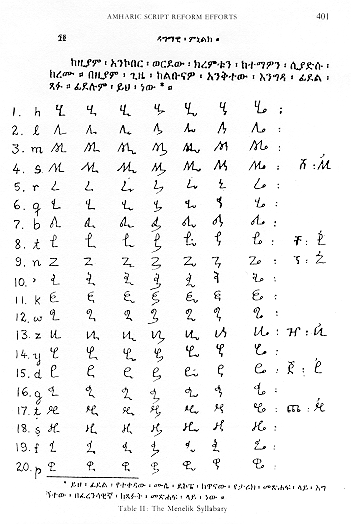| The Cursive Script of Emperor Menelik |
|---|
 |
| Demoz, Abraham, ``Amharic Script Reform Efforts'', ``Ethiopian Studies: Dedicated to Wolf Leslau on the Occasion of his 75th Birthday November 14th 1981, Otto Harrassowitz, 1983 |
| The Cursive Script of Emperor Menelik |
|---|
 |
| Demoz, Abraham, ``Amharic Script Reform Efforts'', ``Ethiopian Studies: Dedicated to Wolf Leslau on the Occasion of his 75th Birthday November 14th 1981, Otto Harrassowitz, 1983 |
With the additional symbols for palatals the Ethiopic syllabary had become quite an adequate medium for the writing of Amharic. The reforms that followed were therefore merely concerned with some further refinements. They aimed at making the script:
We might examine the earliest of the modern reform efforts, namely the one
attributed to Emperor Menelik, in light of the aims cited above. In the
absence of any recorded discussion or commentary on the Menelik syllabary
we have to rely mainly on internal evidence from the proposed syllabary to learn what the aim of the author might have been in designing it. The author has
sought to make the syllabary easier to learn by making the vocalization
affixes completely uniform and by reducing the number of basic symbols. He achieved this reduction in a number of ways. Firstly he eliminated the
``superfluous'' symbols inherited from Ge'ez
(



 )
and the symbols for labialized consonants which he apparently believed, and not without reason, not to be strictly necessary for the writing of Amharic. Secondly, he derived the palatal symbols from their non-palatal counterparts by the mere addition of a diacritic (in this case an apostrophe at the top left of the base letter). He thus reduced the number of basic from thirty-five to twenty -- a reduction of over forty percent. The author also sought to make the letters easier and faster to write by making them truly cursive. Each of the letters can be written with one stroke without lifting the pen and generally without retracing any part of the letter. Not surprisingly, the similarity in shape between Menelik Script and the script proposed more than three quarters of a century later by Zeev Raz (which script is avowedly cursive) is a striking one.
)
and the symbols for labialized consonants which he apparently believed, and not without reason, not to be strictly necessary for the writing of Amharic. Secondly, he derived the palatal symbols from their non-palatal counterparts by the mere addition of a diacritic (in this case an apostrophe at the top left of the base letter). He thus reduced the number of basic from thirty-five to twenty -- a reduction of over forty percent. The author also sought to make the letters easier and faster to write by making them truly cursive. Each of the letters can be written with one stroke without lifting the pen and generally without retracing any part of the letter. Not surprisingly, the similarity in shape between Menelik Script and the script proposed more than three quarters of a century later by Zeev Raz (which script is avowedly cursive) is a striking one.
There is no record that Menelik ever attempted to have the ingenious new script implemented on any scale.